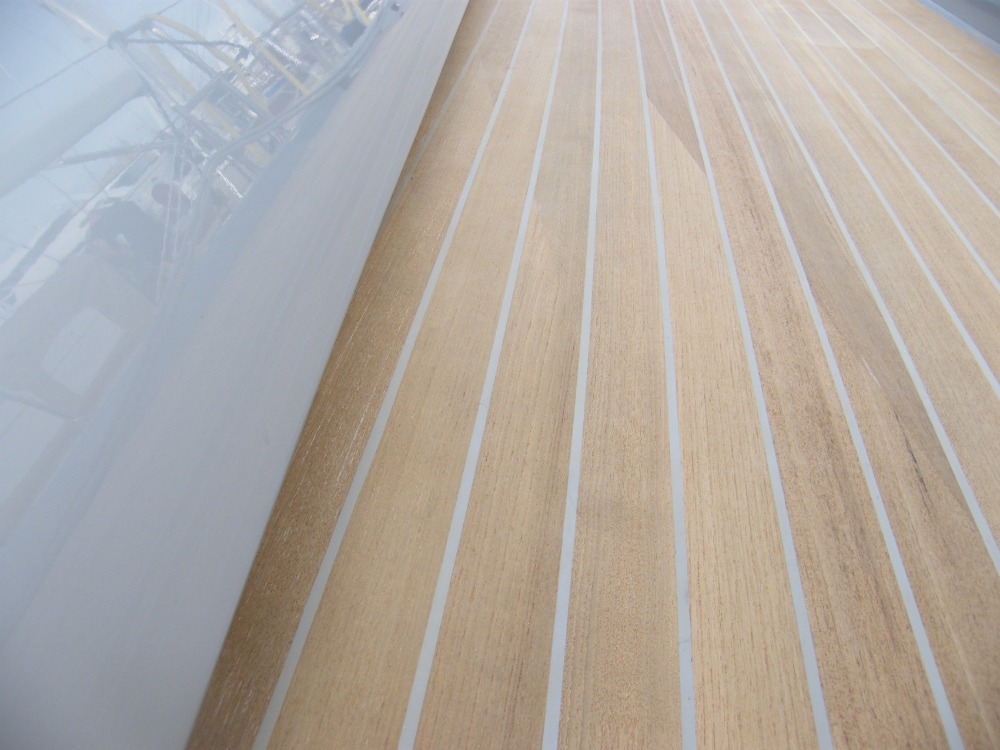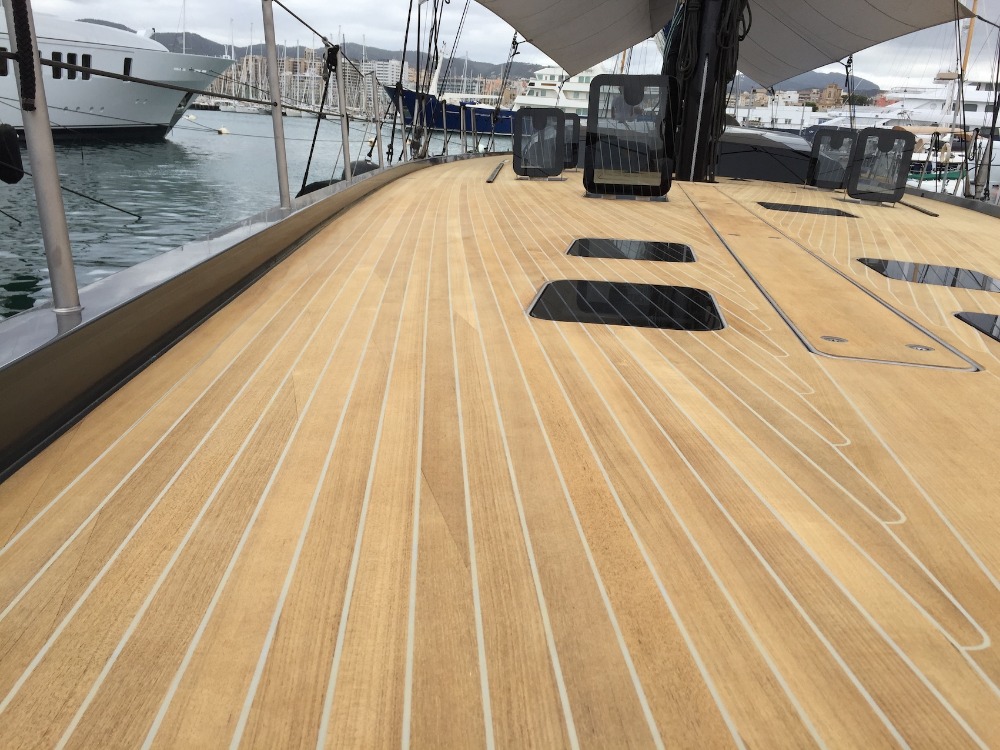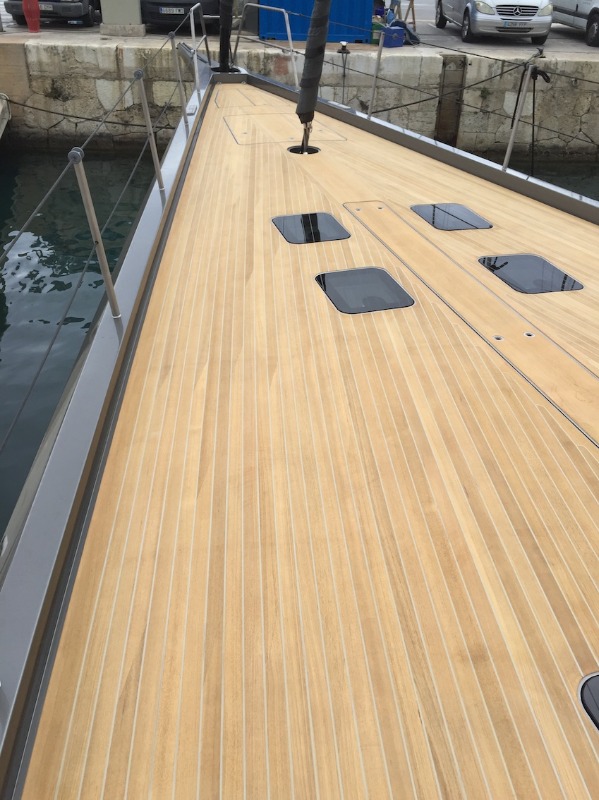Teak decks: grey caulking vs black caulking
Teak deck specialists discuss the pros and cons of the latest caulking colour trend on superyachts…
Is grey the new black? Judging by the rise in the number of sailing superyachts on the water using grey-coloured teak deck caulk – as opposed to the more traditional black caulk – it seems so. The main reason for yacht designers and owners to prefer grey caulking is aesthetic, as the colour arguably makes the deck look more modern and sleek, particularly on modern sailing yachts that have large expanses of exposed deck. The trend can be traced back some years, with Vitters-build S/Y Ghost believed to be one of the first yachts to be re-caulked with custom-made grey caulk from Teak Decking Systems in 2009 as no other grey-coloured deck caulking products were commercially available at the time.
“I believe Ghost was the first well-known yacht to use grey caulk and she certainly started quite a trend,” recalls Robert Eldridge of Palma-based Ocean Refit, which oversaw the yacht’s re-caulking. “She was launched in 2005, and her deck seams were originally caulked with a grey adhesive sealant from the building industry, which quickly broke down in sunlight. Since her re-caulking project, we’ve worked on at least one deck with grey caulk every year, and now it seems to have become even more popular than black.”
While it may be more aesthetically appealing, grey caulk products have come under scrutiny in the industry for issues with application, functionality, long-term durability and upkeep. “Grey and white caulking is not as durable as black and the process for application leaves no room for error,” explains Aaron Nielsen of Ideal Teak. “Where black caulking can be sanded after 24-hours, white and grey need more time to cure. We leave production panels to cure for at least a week before sanding, otherwise the grey or white caulking will shrink and leave lower seams in the teak and need to be re-caulked. We definitely let clients know that we don’t recommend white or grey caulking and can't offer the same confidence as with the black.”
A good result can still be achieved with white or grey caulking in a teak deck, but it requires a little more dedication and specialisation in the application process by deck installers and yacht builders...
In terms of the durability of different coloured caulk, Eldridge acknowledges that black pigment can hide all manner of useful chemicals that improve adhesion and durability of the product, and certain beneficial qualities of caulk products are lost by the addition of other pigments. He does point out, however, that a good result can still be achieved with white or grey caulking in a teak deck, but it requires a little more dedication and specialisation in the application process by deck installers and yacht builders.
“We can obtain excellent results when using grey caulk in a new deck situation, but with a re-caulking scenario we first make a thorough appraisal of the condition of the existing deck before agreeing to use grey caulk,” recommends Eldridge. “We do not recommend grey caulk for the re-caulking of old and tired decks suffering water ingress through failed caulk seams, possible corrosion in the case of steel or aluminium vessels, poor teak adhesion or excessive movement in the teak due to being bonded with a thick layer of a flexible adhesive compound. In these cases, a replacement deck might be the best option, but when budget or other restraints don’t allow for this then re-caulking with a traditional and well-proven black caulking product is the best solution.”
Rasmus Petersen of H.Y.S. Yachting also agrees that grey caulking can be a reliable product, if the correct precautions are taken. “There are so many products out there, of which some are a lot less reliable than others,” Petersen adds. “The procedure of applying the grey caulking demands a lot of attention. In short, many things can go wrong but they don’t have to if the proper procedures are undertaken with the right product.”
"The adhesion of pale-coloured caulks, though adequate for the job, is not quite as strong as black caulk, and therefore a little more attention should be paid to this issue..."
From a maintenance and upkeep perspective, crew should pay more attention to a teak deck with grey caulking. “All teak decks should be inspected regularly for any localised loss of adhesion between caulk and teak – this can normally be identified as the deck dries from a washdown, as open seams will retain water longer and will be visible on the surface of the teak and at the edge of the caulk seam,” advises Eldridge. “Of course, this occurs with black caulk too, but it should be kept in mind that the adhesion of pale-coloured caulks, though adequate for the job, is not quite as strong as black caulk, and therefore a little more attention should be paid to this issue. A repair in time will prevent water ingress, which could damage steel or aluminium structural decks.”
In terms of cleaning, Eldridge points out that dirt is much more visible against a pale-coloured caulk than against black, and if the deck is not cleaned frequently, staining of the caulk surface can occur. “Normally this is quickly removed with just a very light sand, that need not reduce the thickness of the teak, but just skims the surface to brighten it up,” he concludes. “Doing so will also help the deck, keeping the teak smooth and the caulk flush, improving water runoff, and preventing dirt taking a hold on a worn teak deck surface.”
All images courtesy of Ocean Refit
Profile links
HYS Two Way Radio Walkie Talkie Co., Ltd.
Click here to become part of The Superyacht Group community, and join us in our mission to make this industry accessible to all, and prosperous for the long-term. We are offering access to the superyacht industry’s most comprehensive and longstanding archive of business-critical information, as well as a comprehensive, real-time superyacht fleet database, for just £10 per month, because we are One Industry with One Mission. Sign up here.








